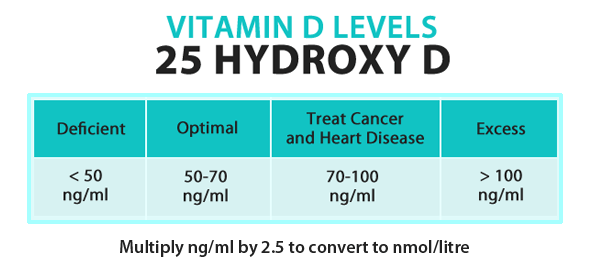What Does Vitamin D Deficiency Look Like?
By Dr. Mercola
New research has emerged linking low vitamin D levels with a risk of cognitive decline and mental impairment, according to studies conducted on elderly Chinese.
Duke-NUS (a collaboration between Duke University in North Carolina and the National University of Singapore)1 announced the deficiency is caused primarily by lack of exposure to sunlight, which scientists already knew humans require to maintain strong bones and healthy muscles.
The new research has now broadened to encompass vitamin D as necessary for optimal brain function.
European and North American studies that have associated low “D” levels with cognitive decline further support previously noted heart and neurodegenerative diseases in individuals with the same deficiency. News-Medical observed:
How Much Vitamin D Is Ideal?
The Institute of Medicine (IOM) recommends 20 nanograms per milliliter (ng/ml) of serum concentration of 25-hydroxy vitamin D as an adequate level, or 600 IUs a day up to age 70 and 800 IUs if you’re over 70, but many vitamin D researchers believe that’s not even enough to prevent osteomalacia, let alone take advantage of vitamin D’s additional health benefits.
Fortunately, vitamin D supplements are readily available, but due to government nutrition recommendations for children and the elderly, only informed choices will help people stay on track with the vitamin D levels that will offer optimal health. If you can’t get enough sunshine for whatever reason, then you can take a vitamin D3 supplement.
As a general guideline, research by GrassrootsHealth suggests adults need about 8,000 IUs per day to achieve a serum level of 40 ng/ml. If you do opt for a vitamin D supplement, please remember that you also need to boost your intake of vitamin K2through food and/or a supplement, as well as get your levels tested to be sure you’re safely within the therapeutic range.

Vitamin D in Food
Foods containing vitamin D and their recommended dietary allowance (RDA), according to the George Mateljan Foundation,12 a not-for-profit food and nutrition science organization, include:
•Four ounces of wild-caught Alaskan sockeye salmon — 128 percent of the RDA
•3.2 ounces of sardines — 44 percent of the RDA
•One egg — 11 percent of the RDA
•Shiitake mushrooms — 5 percent of the RDA
Keep in mind that the RDA is far lower than necessary to raise your vitamin D levels into the therapeutic range, so it’s difficult to achieve enough vitamin D from dietary sources alone. In addition, it’s ideal to get your vitamin D from sunlight because the sun offers a wealth of health benefits above and beyond vitamin D.
The Role of Vitamin D in Disease Prevention
A growing body of evidence shows that vitamin D plays a crucial role in disease prevention and maintaining optimal health. There are about 30,000 genes in your body, and vitamin D affects nearly 3,000 of them, as well as vitamin D receptors located throughout your body.
According to one large-scale study, optimal Vitamin D levels can slash your risk of cancer by as much as 60 percent. Keeping your levels optimized can help prevent at least 16 different types of cancer, including pancreatic, lung, ovarian, prostate and skin cancers.
How Vitamin D Performance Testing Can Help Optimize Your Health
Is it any wonder then that no matter what disease or condition is investigated, vitamin D appears to play a crucial role? This is why I am so excited about the D*Action Project by GrassrootsHealth. Dr. Robert Heaney is the research director of GrassrootsHealth and is part of the design of the D*action Project as well as analysis of the research findings.
GrassrootsHealth shows how you can take action today on known science with a consensus of experts without waiting for institutional lethargy. It has shown how by combining the science of measurement (of vitamin D levels) with the personal choice of taking action and, the value of education about individual measures that one can truly be in charge of their own health.
In order to spread this health movement to more communities, the project needs your involvement. To participate, simply purchase the D*Action Measurement Kit and follow the registration instructions included. (Please note that 100 percent of the proceeds from the kits go to fund the research project. I do not charge a single dime as a distributor of the test kits.)
As a participant, you agree to test your vitamin D levels twice a year during a five-year study, and share your health status to demonstrate the public health impact of this nutrient. There is a $65 fee every six months for your sponsorship of this research project, which includes a test kit to be used at home, and electronic reports on your ongoing progress. You will get a follow up email every six months reminding you “it’s time for your next test and health survey.”
Internet Resources Where You Can Learn More
- Vitamin D for Public Health
- Free Vitamin D Educational Training for Medical Practitioners
- Scientific Consensus Paper Released; Assert Sunlight and Vitamin D are Essential for Human Health
- Vitamin D Resource Page
Where Do We Go From Here?
GrassrootsHealth is now undertaking a new project entitled the Protect our Children NOW! (POC) project. The aim of this project is to acquire participation of at least 500 pregnant women in a community, and to increase their serum levels to the suggested level of at least 40 ng/ml based on the clinical trial by Hollis & Wagner.
In addition, the project will take these results in two years and “march” on the various institutions in the state/government/to the March of Dimes, to demand that action be taken to protect the world’s next generation.
Among other items, the projects expected impact is likely to be a reduction in preterm births, (in some cases up to a 50 percent reduction). The project already has the blessing of the scientists, the physicians at the Medical University of South Carolina (which are implementing it in their practices) and even the insurance company.
Any community can implement this and make a difference for themselves and others. For further information contact Jen Aliano, Project Manager, at jen@grassrootshealth.org.
Sources and References
- 1 The Gerontological Society of America June 19, 2016
- 2 News-Medical July 27, 2016
- 3 Elle UK July 25, 2016
- 4 PHE July 21, 2016
- 5 Health Spectator July 22, 2016
- 6 The Guardian Oct. 30, 2013
- 7 BBC News July 21, 2016
- 8 Psych Central 1995-2016
- 9 AJGP Dec.2006
- 10 BBC News July 21, 2016
- 11 Nutrition Research January 2011
- 12 Vitamin D, The George Mateljan Foundation 2001-2016
The post What Does Vitamin D Deficiency Look Like? appeared first on LewRockwell.

Leave a Reply